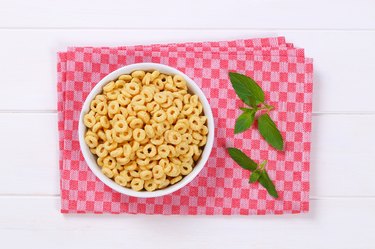
Cheerios is one of the many popular breakfast cereals regularly consumed by many Americans, including diabetics. These breakfast cereals are low in fat, low in sugar and contain a type of fiber called soluble fiber, which has been shown to help lower LDL cholesterol levels. However, like all cereal brands, Cheerios contain carbohydrates, a nutrient that needs to be controlled in order to keep your blood sugar levels within the recommended target of 70 to 130 mg/dL before your meals and no more than 180 mg/dL two hours after the start of your meals.
Carbohydrates and Diabetes
Video of the Day
Carbohydrates are found in sugar, starchy vegetables, fruits, milk, yogurt as well as in grains such as breakfast cereals. Whenever you consume carbohydrates at a meal or at a snack, these carbohydrates are converted to small molecule of sugar, or glucose, during the digestion process. The glucose resulting from the digestion of the carbohydrates then enters your bloodstream to rise your blood sugar levels. Usually, people without diabetes are able to control the rise in their blood sugar levels by producing the right amount of insulin to counteract the glucose in the blood. In diabetics, however, eating too many carbohydrates at once can result in high blood sugar levels, either because of a lack of insulin, as in Type 1 diabetes, or because of a resistance of the body cells to adequately respond to insulin, as in Type 2 diabetes.
Video of the Day
Cheerios Nutrition Information
Although 1 cup of Cheerios only contains 1 gram of sugar per serving, it also contains 20 grams of total carbohydrates, including 3 grams of fiber. Because fiber does not rise your blood sugar levels, you can subtract them from the total carbohydrates, which already include the amount of sugar. In this case, 1 cup of Cheerios therefore contains 17 grams of available carbohydrates. The apple and cinnamon Cheerios contains 29 grams of carbohydrates and 2 grams of fiber per three-fourth cup, which corresponds to 29 grams of available carbs for a smaller portion, as do the banana nut Cheerios.
Cereal and Diabetes
For most diabetics, a meal should not contain more than 60 grams of carbohydrates, according to the American Diabetes Association. Some diabetics also need to further restrict their carbohydrate intake lower than these general recommendations to have good control of their blood sugar levels. If your morning bowl of cereals include 2 cups of regular Cheerios, a cup of milk and a whole sliced banana, your available carbohydrate content would reach 76 grams of carbohydrates, which could result in high blood sugar levels. This could make your blood sugar levels climb above the recommended range.
Cheerios for Breakfast
If you enjoy eating Cheerios for breakfast, you can include them in your diabetes diet in a controlled amount. For example, you could have a cup of regular Cheerios with milk and half of a banana for 41 grams of available carbohydrates. If you choose the flavored varieties of Cheerios, that same breakfast would contain 53 grams of available carbohydrates. You could also have a cup of regular Cheerios mixed with cup of plain yogurt and half a cup blueberries or a cup of strawberries for 40 grams of available carbohydrates. If you need to keep your carbohydrates lower to control your blood sugar levels, cut your serving of Cheerios in half and complete your meal with more protein from eggs, almonds or peanut butter.
- American Diabetes Association: Carbohydrate Counting
- Joslin Diabetes Center: Carbohydrate Counting 101
- USDA National Nutrient Database: Nutrient Data Laboratory
- USDA National Nutrient Database: Cereals ready-to-eat, GENERAL MILLS, CHEERIOS
- USDA National Nutrient Database:45310607, GMILLS APPLE CINN CHEERIOS SWEETENED WHL GRN OAT CEREAL FAMILY SZ, UNPREPARED, GTIN: 00016000484986
- USDA National Nutrient Database: https://ndb.nal.usda.gov/ndb/foods/show/45376408?man=&lfacet=&count=&max=25&qlookup=cheerios&offset=&sort=default&format=Full&reportfmt=other&rptfrm=&ndbno=&nutrient1=&nutrient2=&nutrient3=&subset=&totCount=&measureby=&Q591138=1&Qv=1&Q591138=0.75&Qv=1
- Diabetes Self Management: What Is a Normal Blood Sugar Level?